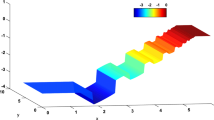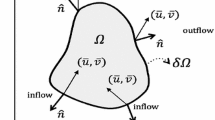Abstract
For conservation laws that admit a convex entropy, Fidkowski and Roe (SIAM J Sci Comput 32(3):1261–1287, 2010) showed that the entropy variables satisfy an adjoint equation corresponding to an entropy-balance functional. In general, this relationship between the entropy variables and the entropy adjoint becomes an approximation when the conservation law is discretized. However, this work shows that the relationship is mimicked discretely for entropy-stable discretizations based on summation-by-parts (SBP) operators and two-point entropy-conservative flux functions; for these discretizations, the discrete entropy variables exactly satisfy the discrete adjoint equation for a particular discretization of the entropy-balance functional. A detailed proof of this result is presented for first-order conservation laws that are semi-discretized using SBP operators with diagonal norm and boundary operators. Subsequently, generalizations to second-order conservation laws, temporal discretizations, and non-diagonal SBP operators are described. The result is verified for steady inviscid and viscous flows.

Similar content being viewed by others
Data Availability
All data generated or analysed during this study are included in this published article. The source code used to generate all data for the current study is available from the corresponding author upon request.
Notes
The choice of two dimensions is to simplify the presentation and does not reflect a restriction on the results.
The notation for the adjoint definition is taken from [9].
The order is important; if we replace \({\mathbf {w}}\) by \({\mathbf {v}}\) first, one would need to account for the relationship between the conservative and entropy variables during differentiation.
Since we are considering a steady problem, the entropy-stability properties of the time marching method are not relevant to our results.
References
Becker, R., Braack, M.: A finite element pressure gradient stabilization for the stokes equations based on local projections. Calcolo 38(4), 173–199 (2001). https://doi.org/10.1007/s10092-001-8180-4
Carpenter, M.H., Fisher, T.C., Nielsen, E.J., Frankel, S.H.: Entropy stable spectral collocation schemes for the Navier–Stokes equations: discontinuous interfaces. SIAM J. Sci. Comput. 36(5), B835–B867 (2014). https://doi.org/10.1137/130932193
Chan, J.: On discretely entropy conservative and entropy stable discontinuous galerkin methods. J. Comput. Phys. 362, 346–374 (2018). https://doi.org/10.1016/j.jcp.2018.02.033
Chandrashekar, P.: Kinetic energy preserving and entropy stable finite volume schemes for compressible Euler and Navier–Stokes equations. Commun. Comput. Phys. 14(5), 1252–1286 (2013). https://doi.org/10.4208/cicp.170712.010313a
Chen, T., Shu, C.W.: Entropy stable high order discontinuous Galerkin methods with suitable quadrature rules for hyperbolic conservation laws. J. Comput. Phys. 345, 427–461 (2017). https://doi.org/10.1016/j.jcp.2017.05.025
Crean, J., Hicken, J.E., Del Rey Fernández, D.C., Zingg, D.W., Carpenter, M.H.: Entropy-stable summation-by-parts discretization of the Euler equations on general curved elements. J. Comput. Phys. 356, 410–438 (2018). https://doi.org/10.1016/j.jcp.2017.12.015
Del Rey Fernández, D.C., Crean, J., Carpenter, M.H., Hicken, J.E.: Staggered-grid entropy-stable multidimensional summation-by-parts discretizations on curvilinear coordinates. J. Comput. Phys. 392, 161–186 (2019). https://doi.org/10.1016/j.jcp.2019.04.029
Del Rey Fernández, D.C., Hicken, J.E., Zingg, D.W.: Review of summation-by-parts operators with simultaneous approximation terms for the numerical solution of partial differential equations. Comput. Fluids 95, 171–196 (2014). https://doi.org/10.1016/j.compfluid.2014.02.016
Fidkowski, K.J., Darmofal, D.L.: Review of output-based error estimation and mesh adaptation in computational fluid dynamics. AIAA J. 49(4), 673–694 (2011). https://doi.org/10.2514/1.J050073
Fidkowski, K.J., Roe, P.L.: An entropy adjoint approach to mesh refinement. SIAM J. Sci. Comput. 32(3), 1261–1287 (2010). https://doi.org/10.1137/090759057
Fisher, T.C.: High-order l2 stable multi-domain finite difference method for compressible flows. Ph.D. thesis, Purdue University (2012)
Fisher, T.C., Carpenter, M.H.: High-order entropy stable finite difference schemes for nonlinear conservation laws: finite domains. J. Comput. Phys. 252, 518–557 (2013). https://doi.org/10.1016/j.jcp.2013.06.014
Fisher, T.C., Carpenter, M.H., Nordström, J., Yamaleev, N.K., Swanson, C.: Discretely conservative finite-difference formulations for nonlinear conservation laws in split form: theory and boundary conditions. J. Comput. Phys. 234, 353–375 (2013). https://doi.org/10.1016/j.jcp.2012.09.026
Fjordholm, U.S., Mishra, S., Tadmor, E.: Arbitrarily high-order accurate entropy stable essentially nonoscillatory schemes for systems of conservation laws. SIAM J. Numer. Anal. 50(2), 544–573 (2012)
Friedrich, L., Schnücke, G., Winters, A.R., Fernández, D.C.D.R., Gassner, G.J., Carpenter, M.H.: Entropy stable space-time discontinuous Galerkin schemes with summation-by-parts property for hyperbolic conservation laws. J. Sci. Comput. 80(1), 175–222 (2019). https://doi.org/10.1007/s10915-019-00933-2
Gouasmi, A., Murman, S.M., Duraisamy, K.: Entropy conservative schemes and the receding flow problem. J. Sci. Comput. 78(2), 971–994 (2019)
Harten, A.: On the symmetric form of systems of conservation laws with entropy. J. Comput. Phys. 49(1), 151–164 (1983)
Hicken, J.E.: Entropy-stable, high-order summation-by-parts discretizations without interface penalties. J. Sci. Comput. 82(2), 50 (2020). https://doi.org/10.1007/s10915-020-01154-8
Hughes, T.J.R., Franca, L.P., Mallet, M.: A new finite element formulation for computational fluid dynamics: I. symmetric forms of the compressible Navier-Stokes equations and the second law of thermodymaics. Comput. Methods Appl. Mech. Eng. 54(2), 223–234 (1986)
Ismail, F., Roe, P.L.: Affordable, entropy-consistent Euler flux functions II: entropy production at shocks. J. Comput. Phys. 228(15), 5410–5436 (2009). https://doi.org/10.1016/j.jcp.2009.04.021
Kreiss, H.O., Scherer, G.: Finite element and finite difference methods for hyperbolic partial differential equations. In: de Boor, C. (ed.) Mathematical Aspects of Finite Elements in Partial Differential Equations. Mathematics Research Center, the University of Wisconsin, Academic Press, Wisconsin (1974)
Lanczos, C.: Linear Differential Operators. D. Van Nostrand Company, Limited, London (1961)
Mock, M.: Systems of conservation laws of mixed type. J. Differ. Equ. 37(1), 70–88 (1980). https://doi.org/10.1016/0022-0396(80)90089-3
Parsani, M., Carpenter, M.H., Fisher, T.C., Nielsen, E.J.: Entropy stable staggered grid discontinuous spectral collocation methods of any order for the compressible Navier-Stokes equations. SIAM J. Sci. Comput. 38(5), A3129–A3162 (2016). https://doi.org/10.1137/15m1043510
Parsani, M., Carpenter, M.H., Nielsen, E.J.: Entropy stable wall boundary conditions for the three-dimensional compressible Navier?Stokes equations. J. Comput. Phys. 292, 88–113 (2015). https://doi.org/10.1016/j.jcp.2015.03.026
Ranocha, H.: Comparison of some entropy conservative numerical fluxes for the Euler equations. J. Sci. Comput. 76(1), 216–242 (2017). https://doi.org/10.1007/s10915-017-0618-1
Ranocha, H., Sayyari, M., Dalcin, L., Parsani, M., Ketcheson, D.I.: Relaxation Runge-Kutta methods: Fully-discrete explicit entropy-stable schemes for the Euler and Navier–Stokes equations. Preprint arXiv:1905.09129 (2019)
Svärd, M., Nordström, J.: Review of summation-by-parts schemes for initial-boundary-value-problems. J. Comput. Phys. 268(1), 17–38 (2014)
Svärd, M., Özcan, H.: Entropy-stable schemes for the Euler equations with far-field and wall boundary conditions. J. Sci. Comput. 58(1), 61–89 (2013). https://doi.org/10.1007/s10915-013-9727-7
Tadmor, E.: Skew-selfadjoint form for systems of conservation laws. J. Math. Anal. Appl. 103(2), 428–442 (1984). https://doi.org/10.1016/0022-247x(84)90139-2
Tadmor, E.: The numerical viscosity of entropy stable schemes for systems of conservation laws i. Math. Comput. 49(179), 91–103 (1987)
Tadmor, E.: Entropy stability theory for difference approximations of nonlinear conservation laws and related time-dependent problems. Acta Numer. 12, 451–512 (2003). https://doi.org/10.1017/s0962492902000156
Acknowledgements
The author thanks the reviewers for their feeback. Their questions and critical remarks helped improve the final manuscript.
Author information
Authors and Affiliations
Corresponding author
Additional information
Publisher's Note
Springer Nature remains neutral with regard to jurisdictional claims in published maps and institutional affiliations.
Appendices
Alternative Form of the Discrete Residual
Here we show that \(R_h({\mathbf {u}}_{h},{\mathbf {w}}_{h})\) defined by (24) is equivalent to the form in (25). First, substitute the strong form residual \({\mathbf {r}}_{i}(t)\) (see (16)) into the discrete residual:
Next, we group the terms in a way that will be more convenient to handle individually:
where we used \({{\textsf {H}}}_{ii} ({{\textsf {D}}}_{x})_{ij} = ({{\textsf {Q}}}_{x})_{ij}\) and \({{\textsf {H}}}_{ii} ({{\textsf {D}}}_{y})_{ij} = ({{\textsf {Q}}}_{y})_{ij}\). The last term on the right-hand side of (54) is already in the form presented in (25); we simply need to use the symmetry of \({{\textsf {M}}}_{ij}\) and swap the indices i and j. This leaves us to focus on the remaining terms.
Consider the first two terms on the right-hand-side of (54). Applying integration by parts to the time derivative term, we find
where, recall, \(\tilde{{\mathbf {u}}}_{i}(0) \equiv {\mathbf {u}}_{0,i}\) and \(\tilde{{\mathbf {u}}}_{i}(T) \equiv {\mathbf {u}}_{i}(T)\).
Finally, we address the spatial difference terms. For the moment, we ignore the temporal integral over the spatial difference terms in (54) and consider only the term containing the x direction entropy-conservative flux \({\hat{{\mathbf {f}}}}_{x}\):
where we used the fact that the difference operator annihilates constants to introduce \({\mathbf {f}}_x({\mathbf {u}}_{i})\) on the first line; i.e. \(\sum _{j=1}^n ({{\textsf {Q}}}_{x})_{ij} {\mathbf {f}}_x({\mathbf {u}}_{i}) = {\mathbf {0}}\). We have also introduced the numerical flux
Continuing, we use the SBP property \({{\textsf {Q}}}_{x}= -{{\textsf {Q}}}_{x}^{\mathsf {T}}+ {{\textsf {E}}}_{x}\) to find
where we used \(\tilde{{\mathbf {f}}}_{x,ii} = {\mathbf {f}}_x({\mathbf {u}}_{i})\) in the boundary term, which follows from the consistency of the numerical flux: \({\hat{{\mathbf {f}}}}_{x}({\mathbf {u}}_{i},{\mathbf {u}}_{i}) = {\mathbf {f}}_x({\mathbf {u}}_{i})\). Note, we also swapped the i and j indices in the double sum on the last line. This is significant, because the numerical flux \(\tilde{{\mathbf {f}}}_{x,ij}\) is not symmetric in the indices.
Using the analogous identity to (56) for the y direction, we have the following:
Substituting (55) and (57) into (54) produces the desired result, i.e. (25).
Derivative of the Spatial Difference Terms in the Discrete Residual
Lemma 3
Let \(\tilde{{\mathbf {f}}}_{x,ji}\) and \(\tilde{{\mathbf {f}}}_{y,ji}\) be the numerical fluxes defined by (26) and let \({{\textsf {D}}}_{x}= {{\textsf {H}}}^{-1} {{\textsf {Q}}}_{x}\) and \({{\textsf {D}}}_{y}= {{\textsf {H}}}^{-1} {{\textsf {Q}}}_{y}\) be diagonal-norm SBP operators in the x and y directions, respectively. Then,
Proof
The two identities in (58) are structurally identical, so it is sufficient to prove the first one. Differentiating with respect to \({\mathbf {u}}_{k}\), we find
where \(\delta _{ik}\) and \(\delta _{jk}\) denote Kronecker deltas. Continuing,
where we have introduced the SBP property \({{\textsf {Q}}}_{x}= -{{\textsf {Q}}}_{x}^{\mathsf {T}}+ {{\textsf {E}}}_{x}\), and we replaced the dummy index i with j in the second sum. Rearranging terms we find
The two last terms on the right-hand side above are zero, because \(\sum _{j=1}^n ({{\textsf {Q}}}_{x})_{kj} = 0\) and because, as shown in, for example, the proof of Theorem 1 of [6],
Therefore, we are left with
The result follows after introducing \({{\textsf {H}}}_{kk}{{\textsf {H}}}_{kk}^{-1}\) on the right-hand side. \(\square \)
Discrete Entropy-Adjoint for Second-Order Conservation Laws
As we did for the discrete adjoint analysis of first-order conservation laws, we begin by defining the weak formulation. For the discrete second-order conservation law we have
where \({\mathbf {r}}_{i}(t)\) is defined by (40). The temporal and inviscid terms that make up \(R_h({\mathbf {u}}_{h},{\mathbf {w}}_{h})\) have previously been shown to be equivalent to (25). Therefore, here we focus on the viscous terms.
Consider the \({{\textsf {H}}}\) inner product between the test function \({\mathbf {w}}_{h}\) and the discrete viscous terms defined by (41). This product is equal to (recall the SBP operator definitions \({{\textsf {D}}}_{x}= {{\textsf {H}}}^{-1} {{\textsf {Q}}}_{x}\) and \({{\textsf {D}}}_{y}= {{\textsf {H}}}^{-1} {{\textsf {Q}}}_{y}\))
In order to simplify the weak-form of the viscous terms, we use the SBP property and the definition of the viscous flux in the normal direction; see Eq. (44).
Finally, we substitute the definitions of \({\mathbf {f}}_{x,j}^V({\mathbf {u}}_{h})\) and \({\mathbf {f}}_{y,j}^V({\mathbf {u}}_{h})\) from (42) and (43), respectively, to obtain
where the entries in the symmetric, positive semi-definite matrix \({{\textsf {M}}}^V\) are defined by
Thus, the semi-linear form in the weak form (60) can be written as
The discrete adjoint analysis for the second-order conservation law is analogous to the analysis presented earlier in Sect. 3.4. Differentiating \(R_h({\mathbf {u}}_{h}, {\mathbf {w}}_{h})\) with respect to \({\mathbf {u}}_{h}\) and replacing the test function with the entropy variables, we find (recall that \({{\textsf {M}}}_{ij}^V\) is a function of \({\mathbf {u}}_{h}\), in general)
where \({{\textsf {A}}}_{0,j}^{-1} = \partial {\mathbf {v}}_{j}/\partial {\mathbf {u}}_{j}\) is symmetric. Next, we add and subtract terms from \(R_h'[{\mathbf {u}}_{h}](\delta {\mathbf {u}}_{h}, {\mathbf {v}}_{h})\) in order to obtain the following expression.
Grouping boundary and volume terms—and recognizing that \({\mathbf {r}}_i(t) = {\mathbf {0}}\) in light of (40)—we arrive at
Consequently, if we define the discretized entropy functional as

then \(R_h'[{\mathbf {u}}_{h}](\delta {\mathbf {u}}_{h}, {\mathbf {v}}_{h}) = J_h'[{\mathbf {u}}_{h}](\delta {\mathbf {u}}_{h})\), as desired.
Rights and permissions
About this article
Cite this article
Hicken, J.E. On Entropy-Stable Discretizations and the Entropy Adjoint. J Sci Comput 86, 36 (2021). https://doi.org/10.1007/s10915-020-01395-7
Received:
Revised:
Accepted:
Published:
DOI: https://doi.org/10.1007/s10915-020-01395-7




